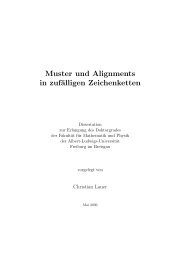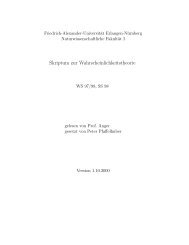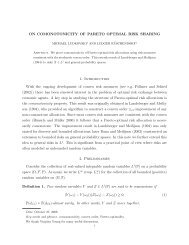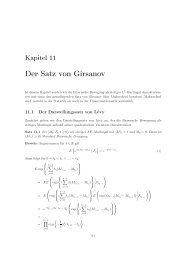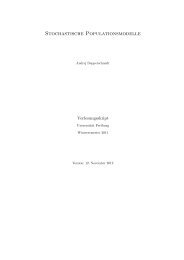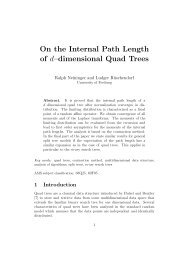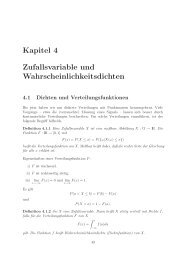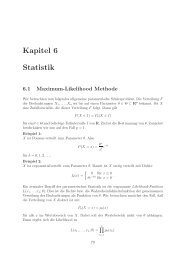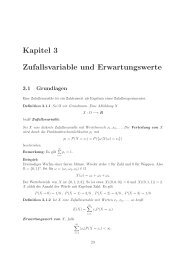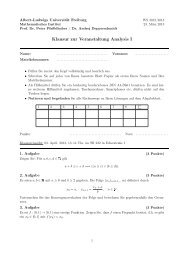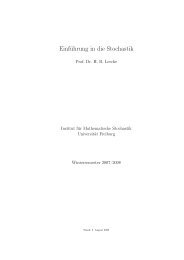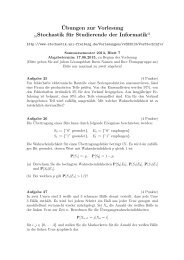Analysis of Markov chain algorithms on spanning trees, rooted ...
Analysis of Markov chain algorithms on spanning trees, rooted ...
Analysis of Markov chain algorithms on spanning trees, rooted ...
Create successful ePaper yourself
Turn your PDF publications into a flip-book with our unique Google optimized e-Paper software.
J. Fehrenbach and L. Rüschendorf 15<br />
j ∈ {0, . . . , l − 1} with v = B j . Let this v be encoded by ¯v. As v \ w c<strong>on</strong>tains<br />
exactly <strong>on</strong>e edge e we obtain p ∈ B(v, ¯v, e) and hence<br />
P(v, w) ⊂<br />
⋃<br />
¯v∈ST(G)<br />
B(v, ¯v, e).<br />
We deduce with Theorem 2.2<br />
∑<br />
F G<br />
(p) ≤<br />
∑<br />
p∈P(v,w)<br />
¯v∈ST(G)<br />
∑<br />
p∈B(v,¯v,e)<br />
F G<br />
(p) = |Ω|,<br />
and with (3.8)<br />
ϱ(F G<br />
) ≤<br />
2n2 m<br />
| ST(G)| · | ST(G)| = 2n2 m.<br />
Together with the rough bound | ST(G)| ≤ m n in (3.7) we finally get for all<br />
ε ∈ (0, 1)<br />
τ s (ε) ≤ 2n 2 m · (n log m + log ε −1 ).<br />
✷<br />
4 Can<strong>on</strong>ical paths for M s<br />
For the c<strong>on</strong>structi<strong>on</strong> <str<strong>on</strong>g>of</str<strong>on</strong>g> can<strong>on</strong>ical paths for M s (G) we shall make use <str<strong>on</strong>g>of</str<strong>on</strong>g> the<br />
multicommodity flow F G<br />
in secti<strong>on</strong> 3. For X, Y ∈ ST(G) for the c<strong>on</strong>structi<strong>on</strong><br />
<str<strong>on</strong>g>of</str<strong>on</strong>g> a 1-flow f XY<br />
for any node v <str<strong>on</strong>g>of</str<strong>on</strong>g> minimal degree in the c<strong>on</strong>tracted graph M =<br />
(V, X ∪ Y ) / (X ∩ Y ) we used by inducti<strong>on</strong> a 1-flow f XvYv<br />
already c<strong>on</strong>structed.<br />
If in this recursi<strong>on</strong> this node v is always uniquely determined, then f XY<br />
is in<br />
fact a 1-flow al<strong>on</strong>g some path in M s (G) since the c<strong>on</strong>structi<strong>on</strong> begins with a<br />
simple transiti<strong>on</strong> between neighbours. To obtain can<strong>on</strong>ical paths for M s (G)<br />
we have to determine which <str<strong>on</strong>g>of</str<strong>on</strong>g> the nodes <str<strong>on</strong>g>of</str<strong>on</strong>g> minimal degree has to be chosen<br />
in the recursi<strong>on</strong> step. We call this node in the following the starting node in<br />
M.<br />
To c<strong>on</strong>struct the starting node in M we assume w.l.g. that M has at least<br />
three nodes. If there is exactly <strong>on</strong>e node <str<strong>on</strong>g>of</str<strong>on</strong>g> minimal degree we call it the starting<br />
node. In the other case we numerate the nodes in V by indices 1, . . . , n and<br />
c<strong>on</strong>sider the subgraph M ′ := (V, X ∪ Y ). Each node with minimal degree in<br />
M we map injectively to the index <str<strong>on</strong>g>of</str<strong>on</strong>g> a node in V and choose as starting<br />
node <str<strong>on</strong>g>of</str<strong>on</strong>g> M that <str<strong>on</strong>g>of</str<strong>on</strong>g> minimal index. A node w in M corresp<strong>on</strong>ds to a c<strong>on</strong>nected<br />
comp<strong>on</strong>ent <str<strong>on</strong>g>of</str<strong>on</strong>g> X ∩ Y and thus to a subtree t w <str<strong>on</strong>g>of</str<strong>on</strong>g> M ′ . A node <str<strong>on</strong>g>of</str<strong>on</strong>g> t w is called<br />
boundary node if it is an endnode <str<strong>on</strong>g>of</str<strong>on</strong>g> edges in M ′ which are not in X ∩ Y but<br />
in X ⊕Y . These edges we call boundary edges. In the tree t w any pair <str<strong>on</strong>g>of</str<strong>on</strong>g> nodes<br />
is c<strong>on</strong>nected by exactly <strong>on</strong>e path in t w . By s w we denote the subgraph <str<strong>on</strong>g>of</str<strong>on</strong>g> M ′<br />
c<strong>on</strong>sisting <str<strong>on</strong>g>of</str<strong>on</strong>g> the paths which c<strong>on</strong>nect boundary node pairs supplemented by<br />
boundary edges. A node in t w is called internal node if its degree in s w is ≥ 3.



